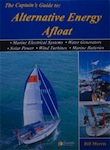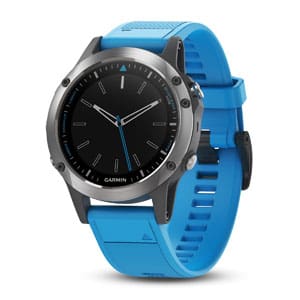The race to combine a wide assortment of technology in small, hand-held wearable devices has recently yielded a new animal: the GPS-capable smartwatch. This miniaturized bundle of standard navigation equipment offers much to the cruising sailor; however, with most GPS watch concepts still evolving, expect to see greater leaps in the next few years.
At this juncture, there are several manufacturers of weather-resistant “smartwatches,” but only one model lives up to what a cruising sailor would call a “true” GPS smartwatch: the Garmin Quatix 5 GPS smartwatch. There are at least two distant contenders, but only Garmin has invested its research and design resources into producing a watch that is NMEA 2000 compatible for GPS charts and waypoint downloads, autopilot control, wind speed, compass course and more.
The sporty yet understated look of the Quatix 5 belies an impressive smorgasbord of features: to begin with, a high-sensitivity GPS and GLONASS antenna, a 1.2-inch-diameter color display, a fiber-reinforced polymer case that's water-resistant to 100 meters, a battery life of up to two weeks depending on type of use, and 64 MB of data storage.
What’s more, the Quatix 5 includes a GHC 20 unit to control the autopilot. And while you are sailing along, blissfully trimming your fingernails and watching for action on the trolling lure, you can stay connected to your StereoActive or ANT-enabled stereo.
If you are willing to part with roughly $550, check out the features online and seriously consider purchasing Garmin’s Quatix 5 smartwatch. This is likely to attain the same classic status as the Casio G-Shock, which was originally released in 1983 and is still a market leader.
A distant contender of the Quatix 5 is the Suunto Spartan Sport, a smartwatch that also features GPS/GLONASS connectivity and waypoint storage, plus visual route navigation in Mapbox, Google Maps and Android via Internet connection.
The Suunto includes an array of other features, including readouts of ETA, barometric pressure, ambient temperature, sunrise/sunset times, and — get this — a storm alarm. How the Suunto receives or calculates data to deduce a storm threat is not clear in the product’s technical description, but hey, we could all sure use a storm alarm.
At about $300 the Suunto certainly is a bit easier on the cruising kitty than the Garmin Quatix 5, but I’m not sure the savings is worth it. It lacks Garmin’s NMEA 2000 connectivity with the vessel’s nav station, and its construction does not have the burly package of the Quatix 5.
Another contender I expect to evolve into a greater competitor is the Apple Watch Series 5, which also features GPS/GNSS capability, along with a compass, a gyroscope, an ECG sensor and, of course, Apple Pay! I certainly wouldn’t want to face a Force 10 storm 1,000 miles offshore without Apple Pay.
Seriously, Apple has the resources to develop a watch capable of serving the growing demands of young, high-tech offshore sailors if it desires to compete in this market. The problem with developing technology for offshore sailors is quite simple: We are a drop in the bucket when compared to the buying power of legions of joggers, cyclists and summer camp kids who want data geared toward physical fitness, not route planning or storm evasion tactics.
The best, or only, choice in offshore-capable GPS watches at this point in time is the Garmin Quatix 5. And, in little time, we can expect this device to get better and less expensive, separating it even further from anything resembling competition.
 |
Circumnavigator-author Bill Morris is the author of The Captain’s Guide to Alternative Energy Afloat and is a frequent contributor to Ocean Navigator.

